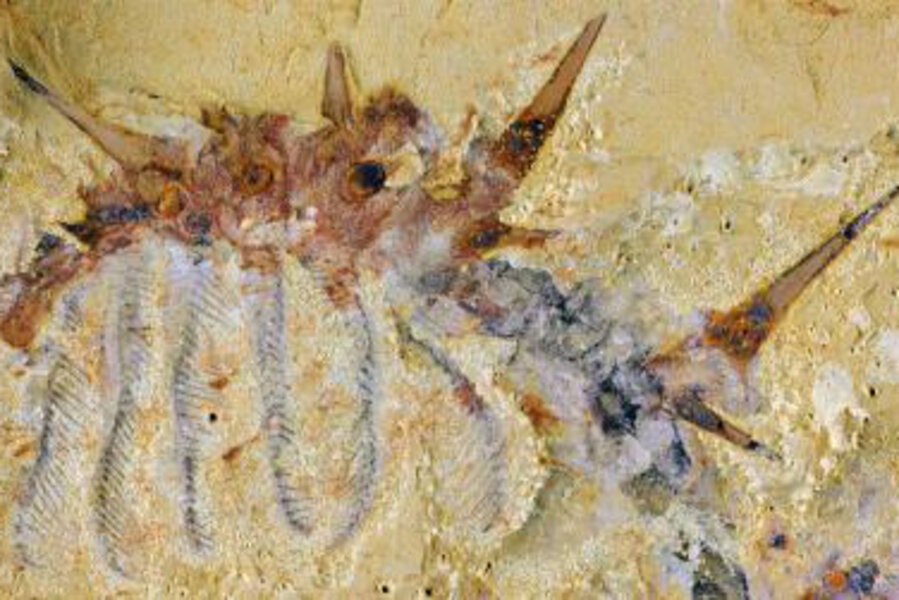Hairy Collins’ Monster: New species of armored worm with 72 spikes
Loading...
Scientists have identified a new species of “super-armored” worm they believe lived on Earth more than 500 million years ago during the Cambrian explosion, a period of rapid evolutionary development.
The wormlike animal was about 4 inches long and featured 30 legs – 18 clawed rear legs and 12 feathery front legs – as well as a phalanx of up to 72 spikes along its back. It lived in ancient oceans and is believed to be one of the first on Earth to develop armor to protect itself from predators. Scientists also believe it is one of the first animals to feed itself by using its feather-like front legs to filter nutrients out of seawater.
Scientists have dubbed the new creature Collinsium ciliosum, or the "Hairy Collins’ Monster,” after paleontologist Desmond Collins, who discovered the fossil of a similar worm-like animal in Canada in the 1980s. Since then, scientists have discovered five species of Collins’ Monster – believed to be the ancient ancestors of modern velvet worms – including one species in Australia.
This fossil was discovered in southwest China, and one of its discoverers – Javier Ortega-Hernández of Cambridge University's Department of Earth Sciences – says that the animal was likely part of this diverse crowd of prehistoric worms that later died out, paving the way for the much cuddlier but less interesting velvet worm.
The fossil was analyzed by researchers from the University of Cambridge in England and Yunnan University in China. Their findings were detailed in a study published Tuesday in the Proceedings of the National Academy of Sciences (PNAS).
“Modern velvet worms are all pretty similar in terms of their general body organization and not that exciting in terms of their lifestyle,” said Dr. Ortega-Hernández, one of the lead authors of the paper, in a statement.
“But during the Cambrian,” he added, “the distant relatives of velvet worms were stunningly diverse and came in a surprising variety of bizarre shapes and sizes.”
The Chinese Collins’ Monster fossil was remarkably well-preserved, enabling researchers to detail everything from its full body organization and digestive tract down to a delicate coat of hair-like structures on its front end. Since its clawed rear legs weren’t suited for walking along the ocean floor, researchers believe the animal instead clung onto sponges or other hard substances while filtering nutrients out of the seawater.
Modern animals, including bamboo shrimp, feed in a similar way, but scientists say the Collinsium ciliosum more closely resembles Hallucigenia, another wormlike Cambrian species.
“Both creatures are lobopodians, or legged worms, but the Collins’ Monster sort of looks like Hallucigenia on steroids,” said Ortega-Hernández.
Both kinds of fossils are “golden tickets” to understand the vast biological diversity of the Cambrian Period, which forms the roots of much of the animal tree of life, according to Marc Laflamme, a paleontologist at the University of Toronto.
“When you find fossils like this, it makes you rethink the possibilities of how ancient life worked,” said Dr. Laflamme, who wasn’t involved in the study, in an interview with National Geographic.
Greg Edgecombe, a researcher of arthropod evolution at the Natural History Museum in London, told LiveScience that the study is “a superb description based on absolutely exquisite fossils.”
In his statement, Ortega-Hernández said that close research into the ancient fossil record can find answers about “all the major biological events responsible for shaping the world we inhabit,” whether those events were able to survive for millennia or not.
“The Chinese Collins’ Monster was one of these evolutionary ‘experiments’ – one which ultimately failed as they have no living direct ancestors – but it’s amazing to see how specialized many animals were hundreds of millions of years ago,” he added. “The origin of life, the early diversification of animals, or the establishment of the modern biosphere, [all] are intimately linked to the complex geological history of our planet.”








